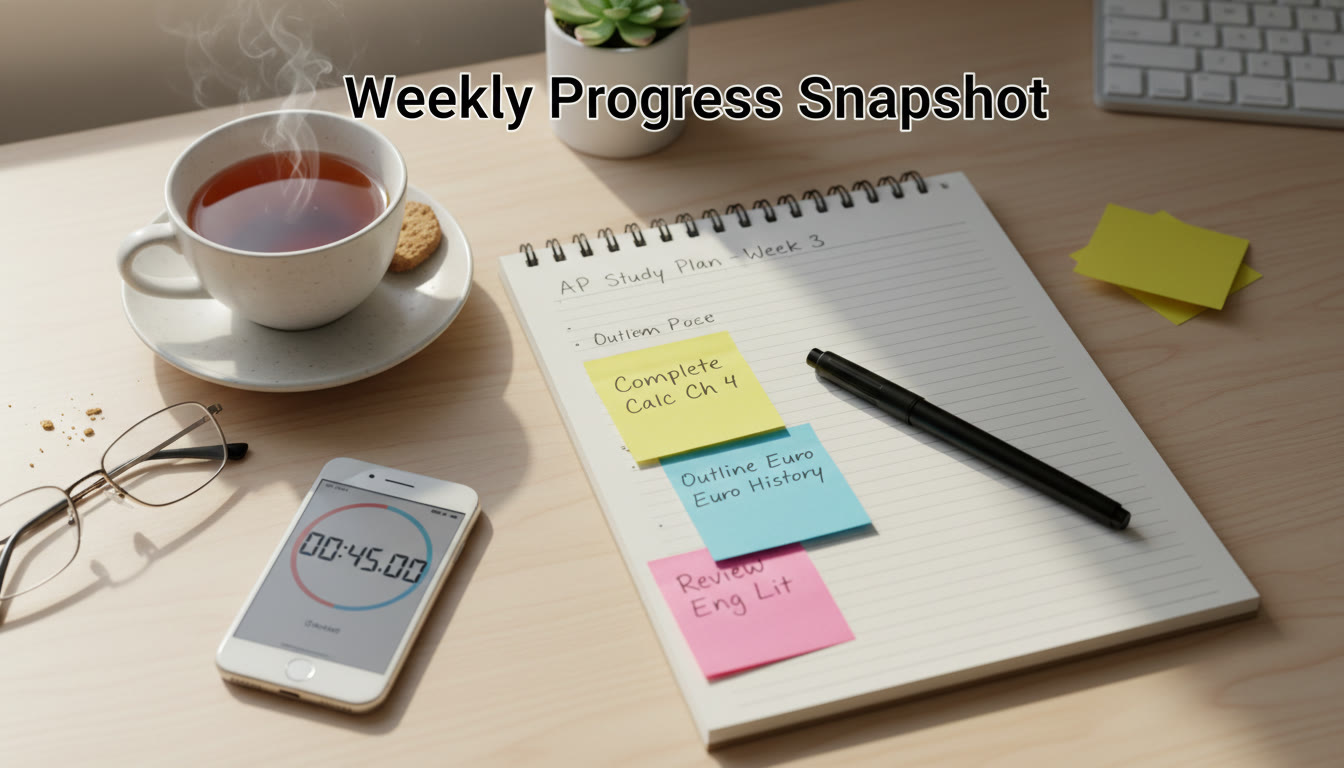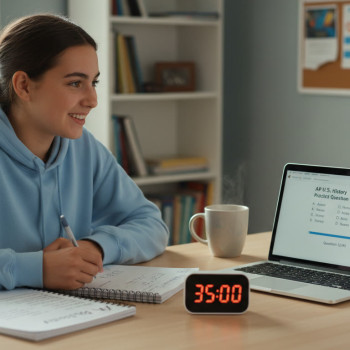Why Scores Aren’t the Whole Story
When your child brings home an AP practice test or clicks submit on an online mock exam, your first instinct might be to look at the number: an 82, a 69, a 93. Numbers are tidy, quick to scan, and easy to compare. But if you lean on them as the only measure of success, you’ll miss the larger, richer picture: how your child learns, why progress is happening (or not), and which small course corrections can produce meaningful gains.
As a parent, your job is partly to be a calm mirror — to reflect what’s true — and partly to be a guide, helping your child translate raw results into next steps. This article gives grounded, practical ways to measure progress without letting scores dominate your relationship or your child’s mindset. You’ll get actionable steps, conversation scripts, and a simple table to track meaningful indicators beyond the percentage on a screen. Along the way, I’ll note where targeted support like Sparkl’s personalized tutoring can fit naturally into a plan, without becoming a crutch.
Reframe Progress: From Snapshots to a Growth Movie
Think of scores as snapshots. They capture one moment — sometimes a blur, sometimes clear. Progress is the whole movie: rehearsal, revision, stumbling, and getting back up. Emphasizing process over single snapshots helps your child take ownership and keeps motivation alive.
What to Notice Instead of Just the Number
- Consistency: Are study sessions happening regularly? Small, steady practice beats occasional cramming.
- Depth of Understanding: Can your child explain a concept well enough to teach it to someone else?
- Strategy Use: Are they practicing active reading, time management, and targeted review?
- Response to Mistakes: Do errors lead to careful review rather than avoidance?
- Stress and Confidence Levels: Is your child calmer approaching tests or more anxious?

Practical Metrics That Matter (and How to Track Them)
Below are simple, parent-friendly metrics that tell a truer story about progress than raw scores alone. Use a weekly or biweekly check-in to note these; the act of recording helps both you and your child see patterns.
Key Metrics
- Time Spent on Focused Study: Quality beats hours; track focused, distraction-free minutes.
- Concept Mastery: Choose 3–5 core concepts per week and mark whether the student can explain them.
- Question Drift: Which question types consistently cause trouble (e.g., multiple choice inference vs. data analysis)?
- Correction Rate: Of the errors made on practice, how many are reviewed and corrected within 48 hours?
- Practice Test Strategy: Are full-length practice tests used for pacing and endurance, not only for grading?
- Emotional Check-In: Rate stress and confidence on a simple 1–5 scale.
Example Table: Weekly Progress Snapshot
| Week | Focused Study Time (min) | Concepts Practiced (3–5) | Correction Rate (%) | Most Tricky Question Type | Confidence (1–5) |
|---|---|---|---|---|---|
| Week 1 | 320 | Vectors, Short Answer Strategy, Periodicity | 40% | Free Response Data Interpretation | 3 |
| Week 2 | 270 | Vectors (review), Practice FRQs, Active Reading | 65% | Time Management on FRQs | 3 |
| Week 3 | 350 | Full-Length Practice Test, Targeted Weakness Drills | 78% | Timing on Section 2 | 4 |
This table is small, friendly, and tells stories: maybe correction rate jumps after a focused review session; maybe confidence improves even without a perfect score. Those are wins.
Conversation Scripts: What to Say (and What Not to Say)
How you talk about scores shapes how your child feels about them. Here are short scripts to try in real moments.
When a Practice Test Goes Better Than Expected
Say: “I noticed you handled those long-response questions more smoothly—what did you change?”
Don’t say: “Great, you’re set—no more work needed.” That dismisses ongoing growth.
When a Score Drops
Say: “That must feel frustrating. Let’s look at three things: what you tried, what tripped you up, and one tiny experiment to try next time.”
Don’t say: “You need to work harder.” That’s vague and often demotivating.
When Your Child Is Defensive or Overly Critical
Say: “I’m proud of the effort you’re putting in. Want to walk through one problem I can help with?” Offer to be a partner, not a judge.
Turn Mistakes Into Data, Not Drama
Academics are a feedback loop. Mistakes are the raw material of improvement. Teach your child to be an investigator:
- Identify the error type (conceptual, careless, time pressure).
- Trace the moment it happened during the test (early, mid, last section).
- Create a tiny repair plan (5–20 minutes) to address the root cause within 48 hours.
That 48-hour window matters. Reviewing errors promptly helps memory consolidation and prevents repeating the same mistake later.
Designing Low-Stakes, High-Insight Checks
Not every check-in needs to be a full practice test. In fact, too many high-stakes checks increase anxiety and reduce the quality of learning. Alternate between:
- Micro-quizzes (10–20 minutes) focusing on a single concept.
- Targeted problem sets that isolate recurrent errors.
- Timed passages or sections to practice pacing.
- One-hour diagnostic sessions every 3–4 weeks to recalibrate larger strategies.
Why Varied Checks Help
Variety prevents “teaching to the number.” Micro-quizzes reveal granular weaknesses; full diagnostics show stamina and synthesis. Use both.
How to Use Practice Tests Strategically
Full practice exams are valuable, but only if used as tools for improvement rather than final verdicts.
When to Give a Full Practice Test
- At the start of a study cycle to identify big-picture weaknesses.
- Mid-cycle to check pacing and endurance—especially for APs with long sections.
- Closer to the exam date to simulate conditions and fine-tune timing.
After the Test: Focus Your Review
Instead of dwelling on the overall percentage, break the test down by question type and concept. Create a 2–3 item repair plan for the next week that addresses the top two recurring issues.
When to Bring in Extra Help (Without Panic)
Bringing in additional support isn’t a sign of failure — it’s a strategic investment. Consider extra help when:
- Your child repeatedly struggles with the same concept despite deliberate practice.
- Motivation is dropping and your child needs fresh routines and accountability.
- Time is tight and you want efficient, targeted improvement (e.g., ahead of the test window).
Sparkl’s personalized tutoring can be useful in these moments: 1-on-1 guidance to identify root causes, tailored study plans, expert tutors, and AI-driven insights to focus practice efficiently. Used sparingly and thoughtfully, tutoring amplifies progress without creating dependency.
Creating a Balanced Study Calendar
Balance matters. A calendar should blend focused study, practice tests, rest, and reflection. Here’s a simple weekly template:
- Monday: Concept-focused practice (45–60 minutes).
- Tuesday: Short problem set + correction review (30–45 minutes).
- Wednesday: Active reading and note refinement (45 minutes).
- Thursday: Micro-quiz and targeted errors (30 minutes).
- Friday: Light review + mental wellness check (20–30 minutes).
- Saturday: Longer practice session or full section under timed conditions (60–120 minutes).
- Sunday: Rest or light reflection; update the weekly table and plan next week.
Tips to Keep the Calendar Realistic
- Block out short, distraction-free sessions rather than long, unfocused ones.
- Include non-academic activities to recharge (exercise, friends, art).
- Let your child help design the calendar so they’re more likely to follow it.
Measuring Progress Over Months: The Growth Indicators
Over a multi-month cycle, look for these larger signals of progress:
- Fewer repeated mistakes on the same concept.
- Improved correction rate and ability to self-correct without help.
- Sustained increase in focused study time, not just last-minute spikes.
- Greater ease with pacing on multi-section exams.
- Emotional resilience — quicker recovery after a low score.
Real-World Example: How Small Changes Compound
Consider Maya, an AP Chemistry student. Her initial practice test score was 72, and she routinely ran out of time on free-response sections. Instead of doubling study hours, she implemented three small changes over eight weeks:
- Focused 20 minutes after each class to summarize notes into one-page concept maps.
- Targeted correction sessions: she reviewed every incorrect FRQ within 48 hours and wrote a one-paragraph “why I missed this” note.
- Two timed sections per week to train pacing rather than endless untimed problem solving.
At her next full diagnostic, her score rose to 81. More importantly, her correction rate increased and her test anxiety dropped. Those compound gains were a product of strategy and habit, not a single miraculous score jump.
How Parents Can Help Without Taking Over
Your role is influence, not micromanagement. Here are practical ways to help that respect your child’s autonomy:
- Be an accountability partner — ask to see the weekly table and celebrate small wins.
- Provide resources when asked and help create structure (timers, quiet spaces, materials).
- Teach emotional skills: breathing techniques, short movement breaks, and perspective checks.
- Watch for burnout: more hours don’t mean more learning if fatigue sets in.
When Numbers Do Matter — And How to Use Them Wisely
Scores aren’t meaningless. They’re diagnostic. Use them to:
- Prioritize weak areas for immediate attention.
- Measure pacing and endurance improvements across simulated exams.
- Track trendlines across multiple diagnostics rather than one-off results.
Don’t let a single percentage define the semester. Instead, place it on your weekly table and ask, “What will we do differently this week because of this result?”
Simple Tools to Keep the Process Smooth
You don’t need fancy systems. A printable table, a shared note, and two short routines will do the job:
- End-of-week review (10–15 minutes): update the Weekly Progress Snapshot table and pick one micro-goal for next week.
- Error-review routine (5–20 minutes): categorize the mistake, write the why, and practice a similar question.

Final Thoughts: Building Confidence and Curiosity
Progress is an ecosystem: habits, mindset, targeted practice, and timely support all interact. Scores are one tile in that mosaic. When parents step back from scoreboard anxiety and invest in meaningful measures — correction rate, focused practice, confidence — they create conditions for genuine, sustainable growth.
Remember: improvement rarely follows a straight line. There will be dips, plateaus, and surprising leaps. Celebrate incremental wins, model resilience, and keep conversations centered on learning rather than judgment.
If you ever want an efficient, personalized boost for your child, consider adding targeted 1-on-1 guidance into the mix. Sparkl’s personalized tutoring pairs expert tutors with tailored study plans and AI-driven insights to highlight the highest-leverage practice. That combination can shorten the feedback loop so your child spends less time guessing and more time improving.
Quick Takeaway Checklist for Parents
- Track process metrics weekly (focused time, correction rate, confidence).
- Use micro-quizzes and targeted drills more often than full tests.
- Turn mistakes into repair plans within 48 hours.
- Keep conversations curious and strategy-focused, not score-focused.
- Bring in personalized support like tutoring when patterns persist or time gets tight.
Parting Note
You are your child’s most important resource: your steady presence, calm tone, and belief in their capacity matter more than any single percentage. With a few simple metrics, consistent review routines, and occasional strategic support, you can help your child own the learning process — and that ownership is the kind of progress worth celebrating.















No Comments
Leave a comment Cancel